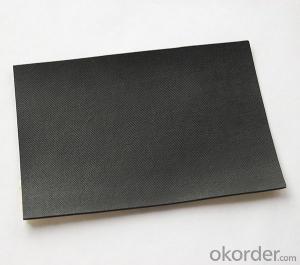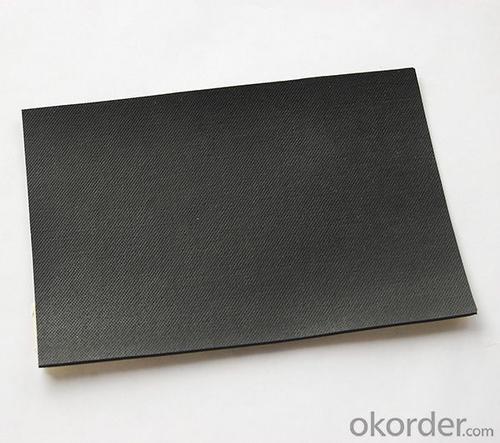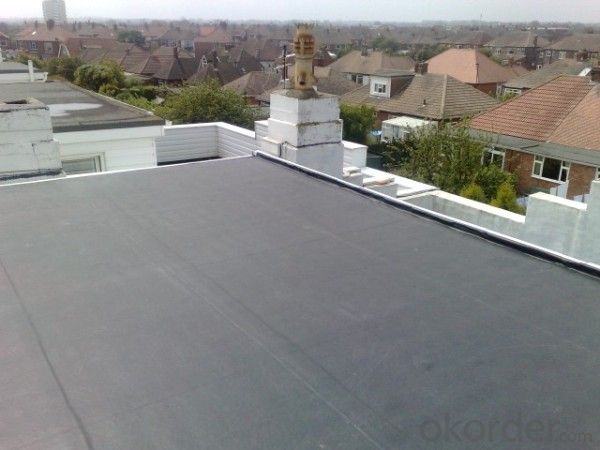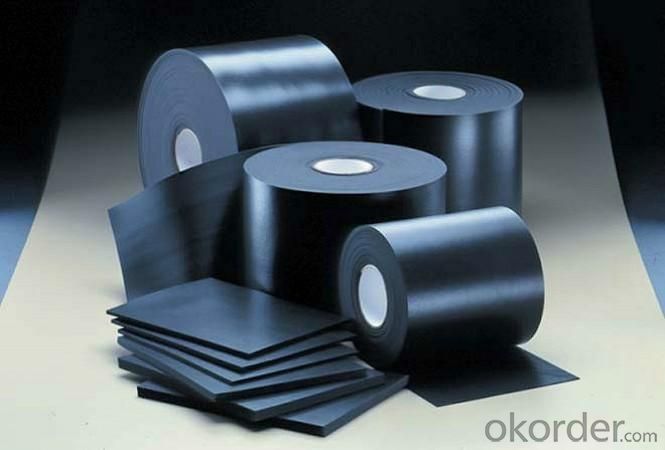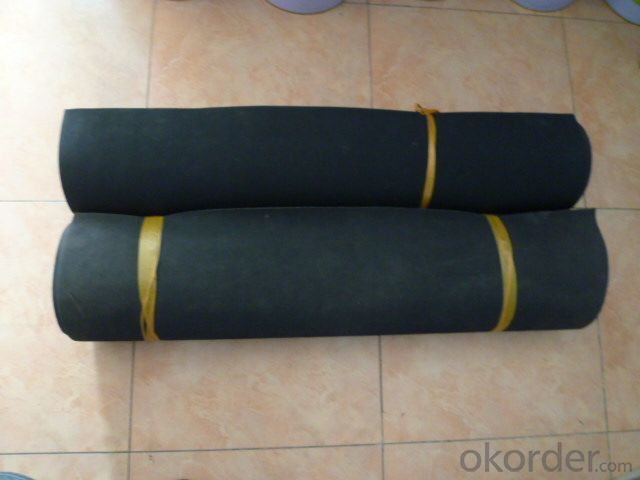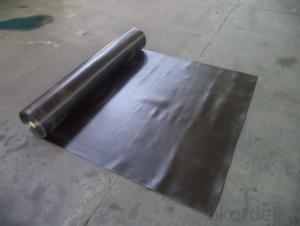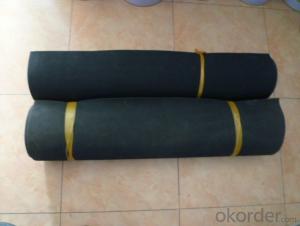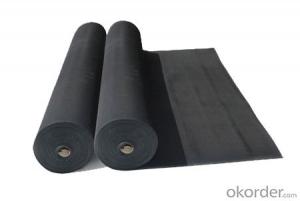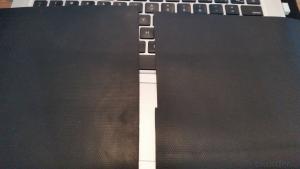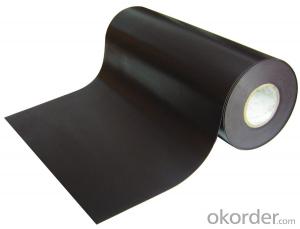EPDM Waterproofing Membrane for Road Base
- Loading Port:
- Shanghai
- Payment Terms:
- TT OR LC
- Min Order Qty:
- 50000 m²
- Supply Capability:
- 5000000 m²/month
OKorder Service Pledge
OKorder Financial Service
You Might Also Like
EPDM Waterproofing Membrane for Road Base
Description Of EPDM Waterproofing Membrane for Road Base:
·Filament polyester filler base sheet material:
·The combination of filament polyester filler base and SBS modified bitumen forms an excellent comprehensive performance and high quality waterproof sheet material;
·High strength waterproof layer and strong water pressure resistance;
·Good performance of breaking resistance, tearing resistance, fatigue resistance, corrosion resistance, mould resistance and weather resistance;
·High tensile strength, high elongation, high adaptive capacity to base shrinkage deformation and fracture;
·Good resistance performance of low and high temperature: It could still work under -20℃ , be applicable to cold and hot regions, especially in chilly region;
·Good workability: It can be constructed by heat fusion method in the four seasons of the whole year and hot-joint is reliable and durable.
·Alkali-free glass fiber filler base sheet material:
·Combination of economical filler base and high performance SBS modified bitumen.
·Higher tensile strength, excellent resistance to high and low temperature.
·Good performance of corrosion resistance, mould resistance, weather resistance and good workability.
·Glass fiber reinforced polyester filler base sheet material:
·It is safe and eco-friendly by using mechanical mounting of construction.
·The product has better dimensional stabiliy.
Main Features of EPDM Waterproofing Membrane for Road Base:
·Polyester felt filler base elastic modified bituminous waterproof sheet material is appropriate for the roof and underground waterproof constructions of industrial and civil engineering projects;
·Waterproof type Ⅱ is appropriate for roof type Ⅰ , Ⅱ and underground waterproof projects;
·Glass fiber reinforced polyester filler base sheet material is appropriate for mechanical mounting single layer waterproofing, but must pass the wind load test;
·Glass fiber felt filler base sheet material is appropriate for the roof of structural stable buildings and underground waterproof projects;
·Exposed surface is suitable to have waterproof sheet material with non-transparent mineral particle as upper surface isolating material;
·The waterproof sheet material with find sand as surface isolating material is appropriate for underground construction projects.
Specifications of EPDM Waterproofing Membrane for Road Base:
| Number | Item | Unit | Value | |
| 1 | Size Variation | Thichness | % | ±10 |
| Width | % | ±1 | ||
| Length | % | Allowed negative | ||
| 2 | Breaking tensile strength at normal temperature | Mpa | ≥7.5 | |
| Breaking tensile strength at 70°C | Mpa | ≥2.3 | ||
| 3 | Breaking elongation at normal temperature | % | ≥450 | |
| Breaking elongation at -20°C | % | ≥200 | ||
| 4 | Tear strength | KN/m | ≥25 | |
| 5 | Impermeability(30min) | * | 0.3Mpa no leakage | |
| 6 | Bending at low tempreture | °C | ≤-40 | |
| 7 | Stretch tensor at heating | Elongate | mm | ≤2 |
| Shrink | mm | ≤4 | ||
| 8 | Air oven aging(80°C×168h) | Tensile strength at break retained | % | ≥80 |
| Elongation at break retained | % | ≥70 | ||
| 9 | Anti-alkali | Tensile strength at break retained | % | ≥80 |
| Elongation at break retained | % | ≥80 | ||
| 10 | Nuture weathing at manual simulation | Tensile strength at break retained | % | ≥80 |
| Elongation at break retained | % | ≥70 | ||
Applications of EPDM Waterproofing Membrane for Road Base:
Widely used in roofs, basement, toilet ,swimming pool, and all kinds of industry and civil building waterproofing, reservoir, vivicism, bridge, underground, tunnel and dam waterproofing ,especially to the keystone waterproofing projects which is durability, high corrosion resistance and easy deformation.



IMages of EPDM Waterproofing Membrane for Road Base:




FAQ of EPDM Waterproofing Membrane for Road Base:
1. What are we supplying?
We are specialized in producing Colorful Asphalt Roof Shingle, SBS/APP modified bitumen waterproof membrane, Self adhesive bitumen waterproof membrane, PVC waterproofing membrane, EPDM rubber roofing membrane, Single Component Polyurethane Waterproof Coating, and Spray Polyurea Waterproof Coating
.
2. How Many years experience do we have?
We have been exported to more than 20 countries in the past 15 years.
3. How long do we usually reply your request?
We always reply our customer within 24 hours.
- Q: Can a waterproofing membrane be used on steel surfaces?
- Indeed, steel surfaces can benefit from the application of a waterproofing membrane. These membranes are specifically designed to establish a shield against moisture and water incursion, and they possess the versatility to be utilized on a range of surfaces, including steel. Construction endeavors, including roofs, balconies, and foundations, frequently feature steel surfaces. By employing a waterproofing membrane on these steel surfaces, one can effectively thwart corrosion and harm arising from water contact. It is crucial to carefully choose a waterproofing membrane that suits steel surfaces, while also adhering to correct surface preparation and application techniques to attain maximum performance and longevity.
- Q: Can a waterproofing membrane be used for elevator shafts and stairwells?
- Yes, a waterproofing membrane can be used for elevator shafts and stairwells. Elevator shafts and stairwells are areas that are prone to moisture and water infiltration, especially in below-grade or high-moisture environments. Waterproofing membranes are designed to provide a barrier against water penetration and protect the structure from potential damage caused by moisture. When applied correctly, a waterproofing membrane can effectively prevent water from seeping into elevator shafts and stairwells, keeping them dry and free from water-related issues such as mold growth, deterioration of materials, and structural damage. These membranes are typically made from durable materials such as modified bitumen, PVC, or rubberized asphalt, which offer excellent waterproofing properties. It is important to choose a waterproofing membrane that is specifically designed for below-grade or high-moisture applications. These membranes should have high resistance to hydrostatic pressure, be capable of bridging cracks, and have long-term durability to withstand the constant exposure to moisture. Additionally, the installation of a waterproofing membrane in elevator shafts and stairwells should be done by trained professionals who have experience in waterproofing systems. This will ensure that the membrane is installed correctly, providing an effective barrier against water infiltration. In summary, a waterproofing membrane is a suitable solution for elevator shafts and stairwells as it can effectively prevent water penetration and protect the structure from moisture-related issues.
- Q: Can a waterproofing membrane be used for a commercial building roof?
- A commercial building roof can indeed utilize a waterproofing membrane. In commercial buildings, it is quite common to employ waterproofing membranes to safeguard the roof against water damage and leaks. These membranes typically consist of synthetic materials like PVC or EPDM, which possess exceptional durability and resistance to water penetration. They are applied to the roof surface as a protective layer, effectively preventing water from infiltrating and causing harm to the structure. Moreover, waterproofing membranes are specifically designed to endure various weather conditions, including intense rain, snow, and UV exposure. This makes them suitable for commercial buildings that are exposed to harsh environmental elements. By utilizing a waterproofing membrane, one can ensure the integrity and longevity of a commercial building roof in an effective and long-lasting manner.
- Q: Is a waterproofing membrane resistant to chemicals?
- Yes, a waterproofing membrane is generally resistant to chemicals. Waterproofing membranes are designed to provide a protective barrier against water and moisture, and they are often made of materials that are chemically resistant. However, the level of chemical resistance may vary depending on the specific type of membrane and the type of chemicals it comes into contact with. It is important to consult the manufacturer's specifications and recommendations to ensure the membrane is suitable for the intended chemical exposure.
- Q: Can a waterproofing membrane be used on precast copper surfaces?
- Yes, a waterproofing membrane can be used on precast copper surfaces. The membrane will create a barrier that prevents water penetration, ensuring the durability and longevity of the copper surface.
- Q: Are waterproofing membranes resistant to hydrochloric acid?
- No, waterproofing membranes are generally not resistant to hydrochloric acid.
- Q: Is the waterproofing membrane an insulating material?
- 3, with a metal carcass resistant root puncture waterproofing membrane, such a coil in the metal copper fetal base, there are other metal fetal base of the coil.
- Q: Can a waterproofing membrane be used for underground parking garages?
- Yes, a waterproofing membrane can be used for underground parking garages. In fact, it is highly recommended to use a waterproofing membrane in these types of structures to prevent water infiltration and damage. Underground parking garages are prone to water seepage from the surrounding soil, and the constant exposure to moisture can lead to structural deterioration, corrosion of steel reinforcements, and the growth of mold and mildew. A waterproofing membrane acts as a barrier, preventing water from penetrating the walls and floors of the garage. It is applied to the exterior surfaces of the structure, providing a protective layer that keeps the interior dry and free from water-related issues. The membrane should be selected based on the specific requirements of the project, considering factors such as the type of construction materials, the groundwater conditions, and the anticipated level of water pressure. Additionally, proper installation techniques and regular maintenance are crucial to ensure the long-term effectiveness of the waterproofing system.
- Q: Can a waterproofing membrane be used in government or municipal projects?
- Yes, a waterproofing membrane can definitely be used in government or municipal projects. In fact, it is often a crucial component in the construction or renovation of various infrastructure projects such as roads, bridges, tunnels, and buildings. Waterproofing membranes help to prevent water infiltration, which can cause damage to the structure and compromise its integrity. By using a waterproofing membrane, government and municipal projects can ensure the longevity and durability of their infrastructure, reducing the need for costly repairs or replacements in the future. Additionally, waterproofing membranes can also contribute to energy efficiency by preventing moisture intrusion, thus reducing the potential for mold growth and improving insulation properties. Overall, the use of a waterproofing membrane in government or municipal projects is highly recommended to enhance the lifespan and functionality of the infrastructure.
- Q: Can a waterproofing membrane be used on precast stone block surfaces?
- Yes, a waterproofing membrane can be used on precast stone block surfaces. Waterproofing membranes are commonly used to prevent water penetration and moisture damage in various types of surfaces, including precast stone blocks. These membranes are designed to create a barrier against water, preventing it from seeping into the surface and causing issues such as mold, deterioration, or structural damage. Applying a waterproofing membrane to precast stone block surfaces can help enhance their durability and longevity by protecting them from water-related problems. However, it is important to carefully follow the manufacturer's instructions and ensure that the chosen waterproofing membrane is suitable for the specific type of precast stone block surface being treated.
Send your message to us
EPDM Waterproofing Membrane for Road Base
- Loading Port:
- Shanghai
- Payment Terms:
- TT OR LC
- Min Order Qty:
- 50000 m²
- Supply Capability:
- 5000000 m²/month
OKorder Service Pledge
OKorder Financial Service
Similar products
Hot products
Hot Searches
Related keywords
